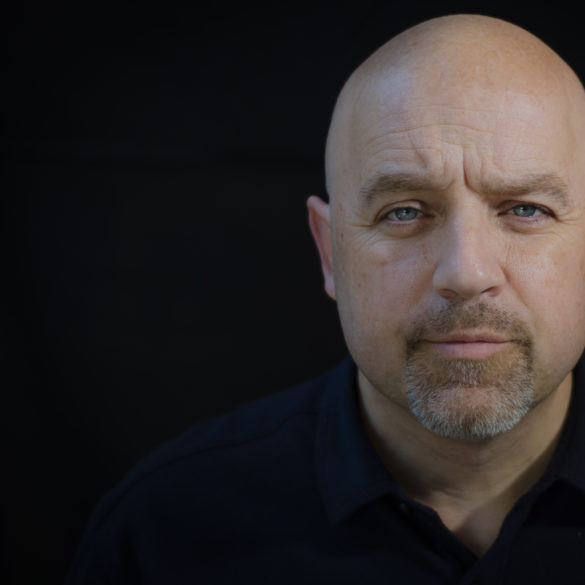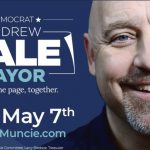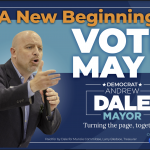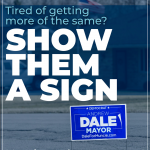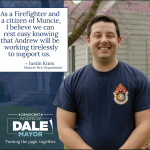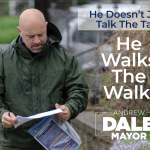In the digital age, politicians are learning to navigate new rules of communication to appeal to voters.
Andrew Dale, a Democrat who ran for Muncie mayor this year, knows the value of having a good team by his side. Andrew lost to Terry Whitt Bailey by just 256 votes in the primary elections. He and his social media campaign manager, Cameron Grubbs, worked together for five months leading up to the primaries to create a digital campaign.
Dale says any campaign has to be about the voters in order to be successful.
“It was more important for the content and the visuals to appeal to people than it was necessarily to ourselves,” Dale says of the digital side of his campaign.
Grubbs agrees. “It’s got to be just a whole synergy,” he says. “You’ve got your content and you’ve got a message, and you’ve got to have the images to make it compelling to where people want to hear more about you.”
Politics and social media go hand-in-hand in the digital age. According to a 2018 study by Pew Research Center, more than 50% of Americans say they’ve used social media to engage in politics and social justice activities. This could include things like changing their profile picture to support a cause, getting information on political rallies, and following political hashtags, according to Pew Research.
The same study found roughly a third of Americans who use social media are involved in some sort of political group or forum, and another 32% say they have also attempted to convince others to join in on a political cause.
Terri Towner, a professor of political science at Oakland University in Rochester, Michigan, says it’s absolutely vital for a politician to have a strong digital campaign. According to Towner, digital advertising is among the most important things a candidate can spend money on.
Towner also says that a social media team is necessary for any political campaign.
“You need to have someone that is posting, monitoring your social media pages, making sure that you are posting information in a timely manner, and that that information is relevant,” Towner says.
Grubbs says that most of Dale’s digital campaign focused on Facebook, their most popular platform. Grubbs says Facebook was his favorite medium to communicate with voters because it allowed for more long-form posts.
Dale says that one of the most important things a campaign can have is consistency. He and Grubbs worked together to create a posting schedule for the five months leading up to election day. Dale says that while this posting schedule was structured, they made sure to leave room for spontaneous posts should something unexpected happen.
“You have to have a consistent brand,” Towner says. “You’re marketing yourself like a product.”
When it comes to marketing, audience is crucial for a political campaign. A Butler University article notes that the 2004 George Bush presidential campaign was the first to use microtargeting to reach voters. Microtargeting is a process of collecting data and using it to figure out what issues small subsections of voters care about.
The Bush campaign used microtargeting to analyze what publications voters subscribed to, the issues they were passionate about, and platforms the campaign could use to flip Democratic voters.
For Grubbs, when it came to the content of the posts, it was important to make sure the three points of Dale’s campaign: accountable leadership, thriving neighborhoods, and economic growth, were conveyed in his posts.
“That’s kind of what made it easier for me because he had a strong message. All I had to do was make it look good, “ Grubbs says.
As mayor, Dale says he wanted to eliminate what he believed to be corruption in Muncie by making government affairs and goals more accessible to the public. On his website, he details this goal with specific initiatives, such as starting an ethics commission for the City of Muncie and creating an online portal for Muncie residents to see how the city spends its money, and how he would have carried them out.
These improvements to transparency in city government were proposed during the ongoing FBI investigation into the City of Muncie. So far, the investigation has led to four federal cases, with one Muncie official convicted of fraud and money laundering.
Dale says he wanted to come across as honest and authentic, and he says Grubbs and he worked together to make sure their messages matched their intent.
Towner, whose current research focuses on what digital strategies are effective for younger voters, says that Generation Z—people born between 1997 and onward—in particular, is good at detecting authenticity on the internet.
A report from IBM found that when it comes to marketing, Gen Z ranks authenticity high on their list of priorities. This could be due to Gen Z being digital natives who grew up in the era of “fake news,” according to IBM.
“They know a handled image when they see one,” Towner says. “They want images from candidates that are authentic, honest, off the cuff.”
Towner is currently studying Gen Z and how they perceive online images. In her ongoing research, Towner has found that because Gen Z has grown up with the internet, they are aware when something is being staged. They know when there’s professional lighting, a filter, hair and makeup, etc.
Towner says this skill of identifying “fake” pictures is something that is far less common in older voters. As a result, Gen Z wants to see candidates who post “real” things.
A report released by Morning Consult on Gen Z found that honesty is a huge priority for the generation, with 81% of people surveyed saying it was important. Additionally, Gen Z puts very little faith in government: 78% say America is very corrupt and only 8% say they have a lot of trust in government officials.
Dale believes that in order to have a genuine campaign, you have to have genuine intentions. He compares running a good campaign to cooking a good meal. For it to turn out right, you have to start with fresh ingredients. You have to be careful about how you blend and mix those ingredients together, making sure you consider the purpose of each one.
Dale says he saw his ideas as ingredients, and he and Cameron worked together to blend these ideas with each other and form more complex plans. They made sure to take their voters’ ideas and concerns into account as well, and treat each one with equal care



